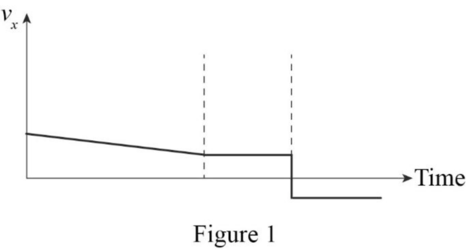
Concept explainers
(a)
The distance
(a)
Answer to Problem 72P
The distance
Explanation of Solution
Write the mathematical expression for Newton’s second law.
Here,
Write the
Here,
After the mug leaves the bar the projectile motion can be considered.
Consider the free body diagram.

Apply Newton’s second law to the free body diagram.
Write the expression for the
Substitute,
Write the expression for
Here,
Substitute equation (III) in(IV).
Here,
Write the kinematic equation for displacement in
Substitute,
Write the kinematic equation for displacement in
Conclusion:
Substitute,
Substitute,
Substitute,
Substitute,
Therefore, the distance
(b)
The velocity of the mug.
(b)
Answer to Problem 72P
The velocity of the mug is
Explanation of Solution
Write the expression for velocity along
Here the
Write the expression for the magnitude of the velocity.’
Write the expression for the direction of velocity.
Conclusion:
Substitute,
Substitute,
Substitute,
Therefore, the velocity of the mug is
(c)
The velocity time graph for both
(c)
Answer to Problem 72P
The velocity time graph for both
Explanation of Solution
Write the expression for the
Conclusion:
Substitute,
The velocity time graph for velocity in

The velocity time graph for velocity in

Therefore, the velocity of the mug is
Want to see more full solutions like this?
Chapter 4 Solutions
Bundle: College Physics: Reasoning And Relationships, 2nd + Webassign Printed Access Card For Giordano's College Physics, Volume 1, 2nd Edition, Multi-term
- air is pushed steadily though a forced air pipe at a steady speed of 4.0 m/s. the pipe measures 56 cm by 22 cm. how fast will air move though a narrower portion of the pipe that is also rectangular and measures 32 cm by 22 cmarrow_forwardNo chatgpt pls will upvotearrow_forward13.87 ... Interplanetary Navigation. The most efficient way to send a spacecraft from the earth to another planet is by using a Hohmann transfer orbit (Fig. P13.87). If the orbits of the departure and destination planets are circular, the Hohmann transfer orbit is an elliptical orbit whose perihelion and aphelion are tangent to the orbits of the two planets. The rockets are fired briefly at the depar- ture planet to put the spacecraft into the transfer orbit; the spacecraft then coasts until it reaches the destination planet. The rockets are then fired again to put the spacecraft into the same orbit about the sun as the destination planet. (a) For a flight from earth to Mars, in what direction must the rockets be fired at the earth and at Mars: in the direction of motion, or opposite the direction of motion? What about for a flight from Mars to the earth? (b) How long does a one- way trip from the the earth to Mars take, between the firings of the rockets? (c) To reach Mars from the…arrow_forward
- No chatgpt pls will upvotearrow_forwarda cubic foot of argon at 20 degrees celsius is isentropically compressed from 1 atm to 425 KPa. What is the new temperature and density?arrow_forwardCalculate the variance of the calculated accelerations. The free fall height was 1753 mm. The measured release and catch times were: 222.22 800.00 61.11 641.67 0.00 588.89 11.11 588.89 8.33 588.89 11.11 588.89 5.56 586.11 2.78 583.33 Give in the answer window the calculated repeated experiment variance in m/s2.arrow_forward
 Principles of Physics: A Calculus-Based TextPhysicsISBN:9781133104261Author:Raymond A. Serway, John W. JewettPublisher:Cengage Learning
Principles of Physics: A Calculus-Based TextPhysicsISBN:9781133104261Author:Raymond A. Serway, John W. JewettPublisher:Cengage Learning
